The name and the format may have changed over the years, but the mission never has: to provide the most up-to-date, accurate and in-depth coverage of the business and technology news across the industry.
To celebrate our birthday year, we’ve focused this feature on 60 great moments in the history of printing, from humanity’s earliest attempts to reproduce an image, through to the latest press developments.
While the rate of innovation has accelerated over the past couple of centuries, it’s a long story that stretches back to pre-historic times and traverses the globe – from medieval China via Middle-Eastern ‘scriptoria’ and Hanseatic Germany, through to the frenetic energy of early 20th-century New York’s newspaper industry and, of course, the UK’s own far-reaching and ongoing contributions.
Before Gutenberg
C. 40,000 BC In Indonesia and Spain, some of the earliest known human–made images are hand prints in caves using red ochre, or stencils made by blowing ochre and using the hand as a mask. The concept of deliberately and repeatedly pressing or stencilling a shaped image onto a surface goes back to the dawn of humanity. No other species on earth does this.
C. 200 BC Paper made from wood pulp is invented in China. The oldest known fragments of paper are part of a map unearthed at Fangmatan in Gansu province dated between 179-141 BC. Chinese tradition credits the invention to a court official, Cai Lun, much later in 105 AD, but it’s more likely that he improved the papermaking process. Paper was originally used for hand written and drawn documents – administrative records, maps, religious texts etc. When it reached Europe it proved longer-lasting than papyrus and cheaper than vellum.
From C. 200 to late 1400s The major religions begin to use written texts to convey their messages for use by religious leaders and followers. A demand for vast numbers of the Torah, Bibles and Qurans saw the establishment of mass hand-written copying centres (scriptoria) throughout the Middle Ages. The need for error-free identical copies was an important driver in the adoption of print.
C. 700 AD Ink-on-paper printing. Dates are debatable but it’s clear from surviving fragments that the first examples of raised-image multiple-copy ink on paper printing originated in China and Korea about 1,400 years ago. The earliest Chinese surviving xylography (woodblock) prints date from the early 7th century. Nearly all surviving examples are Buddhist sutras. There’s evidence for movable type characters made from ceramics in China, with bronze movable type made in Korea in about 1403. The first known two-colour printing is a Buddhist sutra scroll from China, dated 1346.

A German print works rendered in woodcut by Abraham Von Werdt, 1676
1439 to 1799
1439-40 Johannes Gutenberg (full name Johannes Gensfleisch zur Laden zum Gutenberg) is the first European to develop a mass production method for casting movable metal type which could be composited into printable pages and re-used afterward. This was accompanied by the creation of an oil-based ink for paper or vellum, and the adaption of the screw-press into an efficient printing machine. While there are arguments about Korean and Dutch predecessors, Gutenberg’s complete ‘workflow’ was the true beginning of the global printing industry.
1450s onward Printing spreads rapidly throughout Europe and is a key information-spreading factor in both the religious Reformation and the cultural European Renaissance. Early printers such as Christopher Plantin, Aldus Manutius and Claude Garamond, worked to greatly improve the formatting of books and the legibility of type, introducing far more easily readable fonts than Gutenberg’s Gothic black letter calligraphy copies. The Gutenberg-style hand-pulled wooden ‘Common Press’ was to remain unchanged until the adoption of cast iron and mechanisation in the 1800s.
1476 William Caxton is the first person to bring a printing press to England. Having seen printing in Cologne he set up a printing operation in Bruges together with Colard Mansion, a local bookseller, scribe and printer. Caxton’s translation of Recuyell of the Historyes of Troye was the first book printed in English. Moving to Westminster he printed a ‘modern English’ translation of The Canterbury Tales, followed by many secular works plus some bible verses in English. His journeyman Wynkyn De Worde was also a pioneer of English print.
1534 Cambridge University Press was founded, and granted Letters Patent by Henry VIII. It is the oldest continually operated printer-publisher in the UK, although sadly CUP stopped actual printing in 2012 and switched to outside printers. Oxford University acquired a press in about 1585 – although Theoderic Rood was printing bibles and other academic books in Oxford for scholars from 1480, he was independent. The oldest commercial printing company still operating in the UK is thought to be Besley & Copp, founded in Exeter in 1750 by Henry Besley. Honourable mentions (with thanks to Caroline Archer) go to Prym Newey, West Midlands (1760); Edward Mortimer, West Yorkshire (1764); Stephen Austin, Hertfordshire (1768); John Jarrold, Suffolk (1770); Page Bros, Norfolk (1776); Cox & Wyman, Berkshire (1777); JOE Holmes, West Yorkshire (1788); William Pollard & Co, Devon (1781); John Dickinson Stationery, Cambs (1796).
1556 onward Regular newspapers start when the Venetian government publishes Notizie scritte, a monthly news sheet. An early example of news reporting is Michael Entzinger’s 24-page Cologne newspaper covering the defeat of the Spanish Armada. The oldest newspaper still in publication is the Swedish Post-och Inrikes Tidningar, and the oldest British newspaper still in circulation is the London Gazette, dating to 1665. The Times is a relative newcomer, founded as The Daily Universal Register in 1785 before being renamed in 1788. However, as the first The Times anywhere, that’s its complete name; American attempts to rename it ‘The London Times’ are, well, fake news.
1683-84 Mechanick Exercises on the Whole Art of Printing by Joseph Moxon, a London printer. This instruction book for printers was useful at the time and remains an invaluable reference for historians of print. Moxon had earlier (from 1677) written the Mechanick Exercises, or the Doctrine of Handy-Works on skilled trade crafts and tools including bricklaying, house carpentry, joining, smithing, turning and making sun dials. These two collections are regarded as the first serial publication and were collected into single book in 1703.
1750s Printed tissue paper transfers for ceramic decoration are first used on earthenware tiles (and later porcelain, and creamware) by John Sadler and Guy Green in Liverpool. Soon after Robert Hancock perfects transfer printing on fine porcelain ware for the Worcester porcelain factory, for blue underglaze and mostly black overglaze decoration. Hand-engraved copper plates are used.
1798 In Munich, Alois Senefelder invents lithography by accident when trying to develop an acid etched relief printing block made of limestone. He claimed that when his mother asked him to write a laundry list he grabbed the nearest thing to hand – a lump of black wax – and wrote it on a flat stone. After a couple of years experimenting he found that dampening the stone meant that ink only stuck to the wax, and the ink would then transfer to a sheet of paper pressed on top. Over the next two centuries lithography progresses from a fine art process to the dominant print process worldwide by the 1970s and 80s.
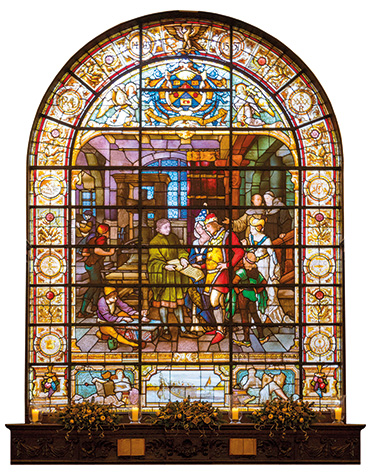
Stained glass window housed at Stationers’ Hall in London showing Caxton in an imaginary scene showing off his print works to King Edward IV
1800 to 1899
1800 Stanhope iron framed press. Charles, 3rd Earl Stanhope, a scientist, inventor and politician, developed the first book press made completely from metal. Others soon followed. Cast iron, a material of the industrial revolution of the 1700s, gave a far more rigid frame than the wooden Common Press dating back to Gutenberg. It was still hand-pulled, but levers increased the force. This allowed much larger multi-page section sheets to be printed for books, and also broadsheet newspapers. Stanhope and similar designs (such as the Columbian) bridged the gap between wooden and later powered presses.
1801 First continuous web papermaking machine introduced by the Fourdrinier brothers at Frogmore Mill in Apsley (close to modern Hemel Hempstead). They were the first to use a design patented in France in 1799 by Louis-Nicolas Robert. The key part was a wire mesh continuous loop conveyor belt where wet pulp was deposited and water drained through. Nearly all modern industrial paper mills use developments of the Fourdrinier process. Frogmore Mill can still be visited today as a working visitor centre, though the original Fourdrinier machine is gone.
1812 German engineer Friedrich Koenig invented the first stream-driven rotary press and installed it at The Times in London, printing the first edition in 1814. He teamed up with another engineer, Andreas Bauer, to build the press. In 1817 the pair set up their own company, Koenig & Bauer, in Oberzell, near Würzburg in Bavaria. The company is still going strong as one of the world’s largest press manufacturers with a history of innovation, and celebrated its 200th birthday last year. Over the years employees left to found their own companies, some big names in their own right, while it acquired established printing and related companies of its own. Today it concentrates on web and sheetfed offset, flexo and special presses.
1835 Photography becomes practical. Henry Fox Talbot produced fixable silver chloride camera negatives on paper, which can be contact-printed to positive. Although Nicéphore Niépce, had taken images in 1822 his process led to the single-shot Daguerreotype, while the multi-use negative Fox Talbot process was the basis of most commercial and industrial photographic materials (films and papers) and techniques, including for printing pre-press, until the coming of digital in the 1990s.
1844 Reichenbach’sche Maschinenfabrik founded in Augsberg by ex-Koenig & Bauer engineers to make presses. By 1909 it was called Maschinenfabrik Augsburg-Nürnberg AG, or MAN. It became a major maker of innovative letterpress, litho and gravure presses. In 1979 it merged with Roland, another German press maker, to become MAN Roland. Today it operates as two separate companies, Manroland Web Systems (in Augsburg) and Manroland Sheetfed (in Offenbach but UK owned).
1875 The first rotary offset litho press is made by Robert Barclay in England. It was invented to print directly onto metal cans. Originally the offset cylinder was covered in treated cardboard; later this was switched to rubber. In the same year Koenig & Bauer developed the first web-fed rotary letterpress machine.
1882 Halftones. Georg Meisenbach in Germany patented and developed the first technically successful halftone screen for full-tonal range reproduction of photographs. He didn’t invent halftones, he just came up with a method that worked. The idea had been around since at least 1852 when William Fox Talbot patented an earlier concept. Meisenbach used parallel lines etched on glass, soon to be followed by cross-line screens, a method used until the development of digital pre-press 100 or so years later.
1886 Ottmar Mergenthaler perfected the first mechanical typesetting machine for the New York Tribune. This output lines of ‘hot metal’ type alloy (called slugs), hence the name of its manufacturer: Mergenthaler Linotype Company. From the 1960s Linotype was a key developer of computerised phototypesetters, scanners and imagesetters before merging with Hell in 1992 and being taken over by Heidelberg in 1997. Today L&M Imaging Systems, a descendent of the UK based Linotype & Machinery hot metal factory, resells plates, platesetters and inkjets.
1896 The Monotype company patented a system to cast separate type characters that allowed corrections. Other major mechanical hot metal typesetting companies followed: Intertype was a Linotype copy, while Ludlow made hot metal display typesetters. Together with Linotype, these machines revolutionised typesetting and lasted until being overtaken by lithography and computerised phototypesetting in the late 1970s and early 1980s.
1894 Wilhelm Müller in Heidelberg bought a press factory from Andreas Hamm, and renamed it Schnellpressenfabrik AG Heidelberg. Today the full name is Heidelberger Druckmaschinen, mostly just known as Heidelberg. It is the largest litho press manufacturer in the world and also makes platesetters, workflow systems and digital toner and inkjet presses.
Late 1800s Development of four-colour process for full-colour printing. There don’t seem to be definite dates for this, but the development of coloured camera filters took away the manual guesswork and many different spot ink colours of chromolithography, to be replaced by far more precise colour separations with a minimum of transparent ‘process’ inks.
1890 Flexography was invented in Liverpool by Bibby, Baron & Sons. It uses flexible relief plates (originally rubber, now often photopolymer), liquid inks and latterly anilox (engraved cell) rollers. Originally intended as a low-cost, lower-quality alternative to letterpress, it was widely adopted for flexible packaging after plastics were adopted. It has been adapted successfully for digital platemaking and the past 10 years have seen enormous improvements in plates, inking and presses so it can now rival litho for quality.
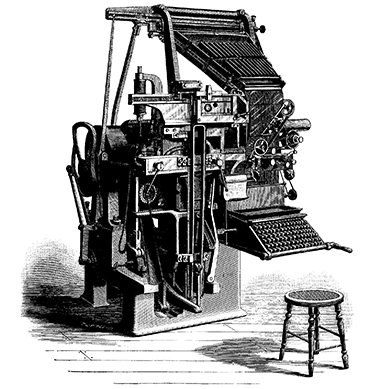
Linotype typesetting machine
1900 to 1939
C 1900 German physicist Arthur Korn invented the Bildtelegraph, a form of facsimile scanning, transmission and recording system that used telegraph/telephone wires. It could read any paper sheet or photograph and reproduce it (with lower quality) at the receiver. There had been earlier fax systems but this one really took off. Later systems such as wirephotos (a 1924 AT&T invention) allowed near instant transmission of newspaper-quality images worldwide, and eventually allowed newspaper pages to be transmitted to remote printing sites.
1910s Screen process is adapted with light-sensitive emulsion for exposure of the screen mesh. Screen printing with cut masks had been invented in China some time around 1000 AD, and came to Europe late in the 18th century, with its use accelerating once affordable silk was available (hence the name silk screen). It became both an art medium and an industrial print process. With a choice of inks, screen can print on most flat/curved solids. Serigraphy is the posh term for screen.
1923 Komori Machine Works is founded in Kitashinmachi, Honjo-ku, Tokyo. By 1925 it has produced an offset litho press and its first four-colour offset press is made in 1958. Komori Europe was set up in Leeds in 1984 – this is now Komori UK, with the European HQ moving to Utrecht in Holland.
1925 Heidelberg powered platen press with ‘windmill’ automatic paper feed launched. Platens date back to 19th-century treadle/flywheel manually operated machines, but the powered Heidelberg was so well built, and for so long (into the 1960s), that many survive in printing works today, especially for small stationery, cutting and creasing and/or foiling jobs. The prominent large oval guard plate marked ‘Original Heidelberg’ makes them stand out.
1935 Kodak scientists developed the world’s first colour scanner for film. This was a drum scanner. After years of further development the first model was sold to Springfield, a Time Inc subsidiary, and used to produce colour separations for Time and Life magazines. Kodak did not play a prominent role in scanners after that, but it led the way for others such as Crosfield, Dainippon Screen, Hell, KS Paul/Linotype and PDI.
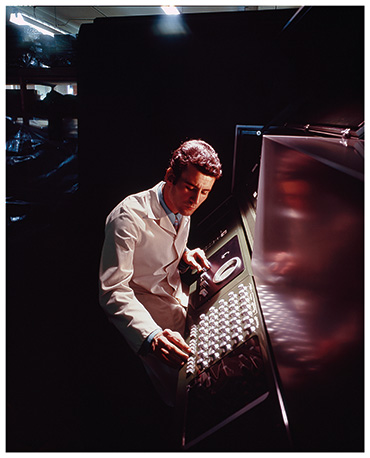 Crosfield Magnascan 450
Crosfield Magnascan 450
1940 to 1969
1941 Bobst in Switzerland introduces the AP900, billed as the world’s first auto platen for cutting and creasing of boxes. The horizontal powered platen was a big improvement on earlier clamshell systems as it allowed efficient higher speed feeding of sheets in one end and out the other. Bobst was founded in 1890 and today is a major international manufacturer of finishing systems (largely for packaging) as well as flexo presses, corrugated board laminators and (via its recent start-up Mouvent), inkjet presses.
1943 Dainippon Screen Manufacturing is established in Japan to sell engraved glass halftone screens for process cameras. The company’s roots date to 1868 as the Ishida Kyokuzan Printing Works in Kyoto. Screen started making process cameras, then its SG-701 colour scanner in 1971 was the first of a respected line. In 1995 it announced its first PlateRite platesetter – today’s models are rebadged and sold by Fujifilm and Heidelberg. Screen is a successful maker of fast web-fed inkjets, also sold via Ricoh.
1947 John Crosfield founds JF Crosfield in London (later renamed Crosfield Electronics). He and colleague Dennis Bent designed an automatic colour registration system for web presses in 1950 (Autotron), followed by a colour scanner (Scanatron) in 1958 and the revolutionary Magnascan 450 enlarging scanner in 1969. Sold to De La Rue in 1974, the company continued until 1989 when the pre-press side was acquired by DuPont and Fujifilm. Today’s FFEI is essentially the former Crosfield R&D operation following a management buyout in 2006.
1949 Rudolf Hell re-establishes business in Kiel, Germany following the second world war. Born in 1901, he developed the Hell Recorder fax in 1929 and worked on TV scanning, beam-following aircraft autopilots and encrypted faxes and acoustic mine exploders. In 1954 he introduced a mechanical gravure plate engraver (Klischograph) and his company developed colour scanners (and Helio-Klischograph scanner-engravers) and phototypesetters in the 1960s, then digital image manipulation (Chromacom) in 1979. The company was acquired by Siemens in 1981 and merged with Linotype in 1990. Rudolf Hell died in 2002.
1951 3M introduces the first practical pre-sensitised aluminium litho printing plates. Prior to that bare aluminium plates had to be coated with a photosensitive layer at the printing works, a messy and inconsistent process. Factory-made pre-sensitised plates were a factor in making litho ever more popular.
1958 The Litho Printer was founded as a monthly UK trade magazine dedicated to fast-expanding commercial uses of lithography. In 1979, owned by Haymarket Publications, it went weekly as Litho Printer Week, renamed LithoWeek in 1983. It increasingly covered all print sectors, recognised by a new name and redesign to become PrintWeek in 1993. It developed an online presence after 1998. PrintWeek was acquired by publisher Mark Allen Group in 2013 and went fortnightly but with expanded daily online news sections.
1960 Haloid Corporation releases the Xerox 914, the world’s first plain paper electrophotographic copier, using dry toner (xerography). It followed more than two decades of development after inventor Chester Carlson started work on electrophotography in his New York kitchen. Haloid renamed itself Xerox and became a major manufacturer of copiers, then laser printers and digital presses, moving from monochrome into colour, refining the xerographic process. Along the way Xerox PARC invented Ethernet, the computer graphical user interface and the first page description language (Interpress, a forerunner of PostScript).
1960 DuPont introduces Dicril, the first commercially available photopolymer letterpress plate, with UV exposure via contact film, and alcohol washout. Other manufacturers followed, including BASF and Toray. The 1970s saw the process refined for water washout and then flexography. Letterpress is now a niche sector but digital photopolymer plates underpin modern flexo.
Mid-1960s First computerised/digital typesetting systems introduced. Volt Autologic has a fair claim to offer the first commercially successful systems with its APS, which used a cathode ray tube to generate characters that were reduced to size though a lens system and projected onto photo paper. CRTs and computer-positioned glass mask photosetters were used into the 1980s, although progressively replaced by laser imagesetters after the late 1970s.
1976 Monotype Lasercomp is the first phototypesetter to use a laser and spinning polygonal mirror to expose type (and basic graphics) from digital data. Dr David Hedgeland, later Monotype technical director, invented the first raster image processor (RIP) to generate instructions for the laser/disc.
1977 Xerox 9700, the first commercially available laser printer, is introduced. Roughly the size of a modern mid-volume digital press, it linked to a computer and output text and graphics at 300dpi onto A4 sheets, at speeds up to 120 sheets per minute. The 9700 and its successors (8400 and the compact 1200) sold mainly into data centres where they replaced typewriter-style line printers.
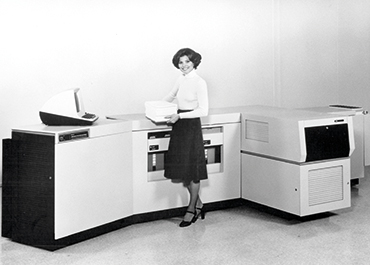
The Xerox 9700
1960s to 1980s Sheetfed and web offset lithography increasingly replaced letterpress as the dominant printing process. This was mainly about efficiency and press speed, but rapid developments in phototypesetting and computers also benefitted litho pre-press more than letterpress.
1977 Canon and HP independently discover the principle of thermal inkjets. Canon engineer Ichiro Endo noticed that a soldering iron touched to a syringe needle full of liquid shot droplets out of the end. John Vaught and a team at HP made a similar discovery. The companies decided to share patents rather than fight in the courts. Thermal inkjets cost less than piezo, but don’t last so long and only work with aqueous inks.
1979 Scitex Corporation introduces the Response 300 colour digital pre-press system. This used microprocessors instead of mainframe computers and initially outsold established Crosfield and Hell products. Scitex was founded in Israel in in 1968 by Ephraim (Efi) Arazi, who had previously worked for the US space programme and co-developed the Apollo 11 TV camera. For the next two decades Scitex was an important developer of colour pre-press and early digital print systems. After Robert Maxwell bought a controlling share of Scitex in 1989, Arazi left and in 1990 set up Electronics For Imaging (EFI), which today is a huge company specialising in digital front ends, MIS and large-format inkjets. Arazi died in 2013.
1980 to 1989
1980-81 The first ‘microcomputer front ends’ appear, using low-cost desktop computers instead of expensive purpose-built terminals to enter text and formatting codes into phototypesetting systems. Early examples were Linotype with the Apple II and Typecraft with the Commodore PET/8000. Initially there was no preview on-screen.
1985 Apple Computer announces the Desktop Publishing System. This and its successors changed the world, putting on-screen design, typesetting and layout into the hands of designers rather than compositors and film strippers. Apple’s system combined its Macintosh computer with Aldus PageMaker software accessing Linotype outline fonts, outputting to an Adobe PostScript RIP in a Canon-built Apple LaserWriter A4 laser printer. Linotype simultaneously announced a PostScript RIP for its Linotronic 300 filmsetter.
1982 USA Today is launched by Gannet Newspapers. This is the first daily newspaper to use full-colour editorial photographs and infographics, initially only on the covers. USA Today also pioneered some data transmission techniques to production sites. In 1986 Eddie Shah introduced Today, the first UK colour newspaper, with early poor quality derided as ‘Shahvision’. Mirror Group (then owned by Robert Maxwell) set up the Mirror Colour Institute to solve many of the early quality problems. Associated Newspapers used flexography for its colour presses, bucking the trend to web offset.
1986 ‘Fortress Wapping’ industrial dispute failed to halt News International production, leading to a decline in trade union power and influence in the UK print industry that continues to this day. Rupert Murdoch had moved his newspapers’ production from central London to a new site in Wapping, introduced computer input by journalists and shut out the print unions. The previous two decades had seen frequent strikes over a range of issues. The 1979 Conservative government introduced legislation intended to curb union powers.

Apple Macintosh IIx from 1990
1990 to 1999
1990 Adobe introduces Photoshop, an affordable full-colour image manipulation and pre-press program. Over the next few years Macintoshes and PCs become powerful enough to run it with print-resolution files. Expensive dedicated imaging systems are wiped out and photographers and designers start to do their own imaging, replacing skilled operators.
1991 Kodak introduced the first practical commercial digital camera, the DCS, for £16,000. This was a modified Nikon SLR film camera with a small-frame 1.4 megapixel CCD image sensor linked to a shoe-box-sized but shoulder-luggable external disk with preview screen. Rapidly improving cameras and other manufacturers followed and within ten years digital cameras were outselling film cameras. Film scanning for print all but died out.
1991 UK company 4-Sight creates iSDN Manager data transmission software to support a remote publishing demo project (Shetland-to-London) organised by LithoWeek’s sister magazine XYZ, edited by one Simon Eccles. Linotype sent a scanner demonstrator called Jo Francis. ISDN (Integrated Services Digital Network) used dedicated but cheap phone lines and was widely adopted for job file transmission between printers, publishers and clients throughout the 1990s until it was supplanted by ADSL, then fibre broadband. 4-Sight and rival Hermstedt were major suppliers of ISDN systems.
1992 Encad in the US introduced NovaJet, the first commercial wide-format inkjet printer to use drop-on-demand heads. Most subsequent large-format inkjets used a similar configuration. Inkjets were increasingly used for large sign and display work on flexible plastics, or for fine art and proofing on paper. Today’s most common inks are aqueous (for paper and card), solvent/eco-solvent (for plastics), UV-cured (for rigid/impervious media) and latex (water-based alternative to solvent). Flatbed inkjets with UV-cured inks for rigid media appeared in 2000.
1993 Mosaic, a web browser, was introduced, triggering an ongoing revolution in global communications and business operations that has impacted printing both positively and negatively. The Worldwide Web was invented in 1989 at CERN by Brit Tim Berners-Lee (now a Sir), to run on the Internet that had just been opened to public access. Mosaic, developed by the US National Center for Supercomputing Applications, was the first widely used browser, though it was soon overtaken by Netscape Navigator, then Internet Explorer.
1993 The UK’s Ipex exhibition saw the first two full-colour digital presses launched. Indigo showed the liquid toner E-Print 1000, while Xeikon showed the dry toner web fed DCP-1 (Agfa launched this simultaneously as the Chromapress). Developed versions of both are still made and sell successfully, though Indigo is now part of HP and Xeikon is owned by Flint. These machines were the start of the digital revolution in commercial printing.
Mid-1990s Direct, filmless litho platemaking, usually now called computer-to-plate (CTP), becomes commercially viable after years of false starts. Finally plate manufacturers developed coatings that were sensitive to fast computer-controlled exposure by certain laser wavelengths, while remaining tough enough for normal press run lengths. This simplified pre-press processes, cut costs and labour and boosted plate image quality and accuracy. ‘Processless’ (low- or no-chemical development) plates started to be viable in the 2000s.
1996 Flexographic computer-to-plate (CTF). German Basel Scheel company (now part of Esko) was financed by DuPont to develop a filmless computer platesetter for Cyrel flexographic plates, called CDI (Cyrel Digital Imaging). It uses laser ablation of an integrated black exposure mask on the plate and works with any suitable platemaker. CTF was a big factor in the quality revolution in flexography (also helped by improvements in presses and anilox inking rollers). Honourable mention to Kodak’s later Flexcel CTP system, which uses a different lamination system.
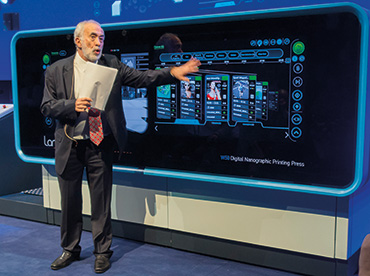
Benny Landa demonstrates his Nanography technology at Drupa 2012
2000s to date
2000 Xerox DocuColor 2000 was the first affordable and practical mid-production full-colour digital dry toner press. It was attractive to mainstream printers and soon outsold all other digital presses to date. The next few years saw Canon, Konica Minolta and Ricoh enter the same market with similar success. Kodak’s NexPress and Xerox’s iGen presses addressed the requirement for higher quality, higher volume digital print, but cost more.
2000 JDF (Job Definition Format) is announced as a multi-party joint development. The aim is to allow any print production system to communicate with any other via a mark-up language based on XML. Today it is widely used to link systems from different manufacturers, although the dream of easy ‘plug and play’ never materialised.
2008 Ryobi demonstrates UV-LED curing for offset litho presses at Drupa, making the process affordable, practical and increasingly popular for general purpose printing. Earlier UV curing had used bulky, very hot-running, expensive and short-lived mercury vapour lamps. Ryobi worked with Panasonic to develop compact UV-LED lamps that run cool, can easily be integrated into conventional presses and rarely need replacing. Other press manufacturers increasingly offer UV-LED or LE (low energy) lamp options.
2012 Benny Landa used a spectacular stage show to introduce Nanography, a new digital printing technology, at Drupa. This was Landa’s second new process, as he worked throughout the 1980s to perfect the liquid toner electrophotography offset digital press technology that was launched by his company Indigo in 1993. Nanography is essentially offset inkjet with nano-scale pigments that can print on most substrates. As of 2018 it remains in beta but has the potential to revolutionise digital cost-performance ratios.
2013 to date. Industrie 4.0, a German title for a combination of interlinking new and old technologies, is predicted to change the way manufacturers (including printers) operate. It’s claimed to be the ‘Fourth Industrial Revolution’. It’s a combination of always-online systems (Internet of Things) sharing data with pattern-detecting analytics and artificial intelligence that can predict problems and suggest improvements, plus more automation including robotics. PrintWeek will cover this and the rest of the ever-dynamic printing industry during the next 60 years!











